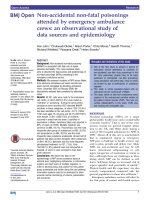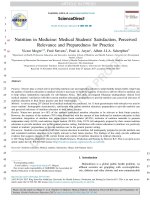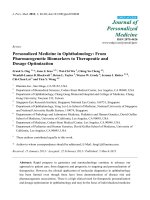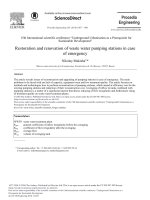Pediatric emergency medicine trisk 2438 2438
Bạn đang xem bản rút gọn của tài liệu. Xem và tải ngay bản đầy đủ của tài liệu tại đây (103.19 KB, 1 trang )
Postmortem specimens Analyses
Blood a
10-mL EDTA tube
Chromosome analysis
4–6 filter paper spots
DNA analysis (requires PCR
amplification)
5-mL heparinized tube
Tandem mass spectrometry for
organic acidemias, urea cycle
defects, fatty acid oxidation
defects
Acylcarnitines
Amino acids
Bile acids
Urine a
Urine 10 mL in 1–2-mL Amino acids
aliquots
Organic acids
Acylcarnitines
Bile acids
Cerebrospinal fluid (CSF)
CSF 3–5 mL in 1-mL
Glucose
aliquots
Lactate, pyruvate
Glycine, serine
Neurotransmitters
Organic acids
Aqueous humor
Aqueous humor
Organic acids
Skin biopsy a
Skin—2 samples, 3-mm Chromosome analysis
diameter each
DNA analysis
Enzyme activity
Comments on collection, storage
Obtain blood by vascular access or
intracardiac puncture
For filter paper spots, apply free-flow
blood to filter paper, saturate through
to back, do not layer drops
Air-dry 3–4 hrs, do not heat. Place in
envelope, refrigerate
Freeze plasma at −20°C or −70°C, store
erythrocytes at 4°C
Collect by bladder catheterization,
suprapubic aspiration
If unsuccessful, irrigate bladder with 20mL normal saline and collect or
perform intrabladder swabs at autopsy
Freeze at −20°C or −70°C
If not collected for clinical care, may be
appropriate to collect postmortem
Freeze at −20°C or −70°C
May be appropriate if blood not
available
Collect by intraocular puncture at
autopsy
Freeze at −20°C or −70°C
Best collected premortem or
immediately postmortem, usually
viable 2–3 days, 1 wk may be helpful
to discuss with specialist
Skin, punch, or incisional biopsy, sterile
technique, 2 sites—flexor surface
forearm, anterior thigh, transport in
sterile tube completely filled with
tissue culture media, viral culture









